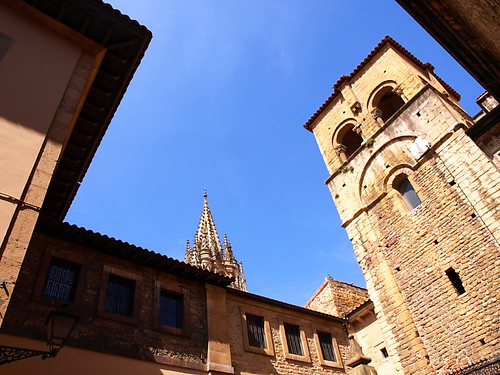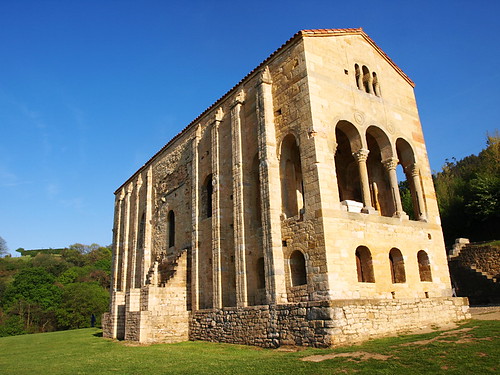We’d recommend that you grab a map from the tourist office and just set off exploring the old town of Oviedo. There’s hardly a street that doesn’t have something of interest. But if we had to pick out our favourite spots, this is what they’d be.
Plaza de la Constitución
As well as the grand town council, the highlight of the square is the 16th century Church of San Isidro de Real. Its one spire was supposed to be two but it was never completed. I love how they’ve used the ancient brick to tell people that they can’t play ball here, it seems like an act of official vandalism. The real ‘find’ lies through an archway next to the town hall. Plaza El Pescador is one of the prettiest plazas in town and the sculptures on it reveal that this is where the people from the country arrived on donkeys to sell their milk to the townspeople who in return would sell them fish.

El Mercado el Fontán
The streets around the market are lined with stalls selling flowers, CDs and the usual market type gear but it’s the indoor market that gives at least two of your senses a treat. The fish are colourful and their varieties plentiful, there are stalls especially for the local ‘top’ dish, the meaty bean stew fabada and as for the cheeses… Asturias cheeses are to die for. Pick up a bottle of Asturian wine here (yes, Asturias does produce wine – even a lot of Spanish aren’t aware of that). I’d recommend Cangas del Narcea for it’s honest, hearty bouquet. Also look out for the milk bottle machine. This is the sort of place that has you wishing you’d opted for self catering. Next to the market is Plaza Fontán which is a popular meeting place for residents. Les Forgaxes is a good lunch spot to try some Asturian cider. For a real cheesy photo moment, stick your head through the cut out of the ‘cider pourer’ at the bottom of the plaza.

The Cathedral and Plaza de Afonso II El Casto
Although the cathedral’s spire shouts its Gothic influences across the rooftops of the city, Romanesque and even what appears to be Arabic influences reveal that this was a monument that was very much a ‘work in progress’ lasting centuries. As sanctuary for important religious artefacts from across Spain during the invasion of the Moors, its played an important part in the country’s religious history. Interesting though it is, it’s quite oppressively gloomy inside (photography not allowed) and I was quite happy to escape back into the light of the plaza on my visit. The plaza is also home to the 18th century Palacio de Valdecarzana and little statue, La Regenta, whose demureness gives little clue that it’s dedicated to a novel (La Regenta by Leopoldo Alas) that caused such a scandal because of its perceived sordid content at the time (1885) that the only place it could be published in Spain was Barcelona.

Palacio de Exposiciones y Congresos Pricesa Letizia
Or Oviedo’s congress and exhibition centre if time is short. Another classic work of modern art in building form by Santiago Calatrava the centre hasn’t been without its setbacks. But now it is a stunning, and typically blinding white monument to the best of contemporary architecture. The centre’s aesthetic white curves dominates Oviedo’s skyline. It’s suggested that the central piece resembles and eyelash – I can see that…but, and cut my tongue out here, I can’t helping thinking ‘transformer’ when I look at it from a distance.

Santa María del Naranco
Lying about 3 kilometres outside of Oviedo, the Church of Santa María del Naranco wasn’t initially contructed as a church but as part of a palace in the 9th century making it the oldest palace in Europe according to the blurb. In reality it appears quite a simple affair, but it’s pre-Romanesque designs have earned it UNESCO World Heritage Site status. Apparently there are all sorts of clues about its history in the design, the number 7 is of particular importance, but those details need the likes of Dan Brown to decode – it was all over my head. There’s not a lot to it but add on the views over Oviedo and a trip here is worth the effort.





Be the first to comment